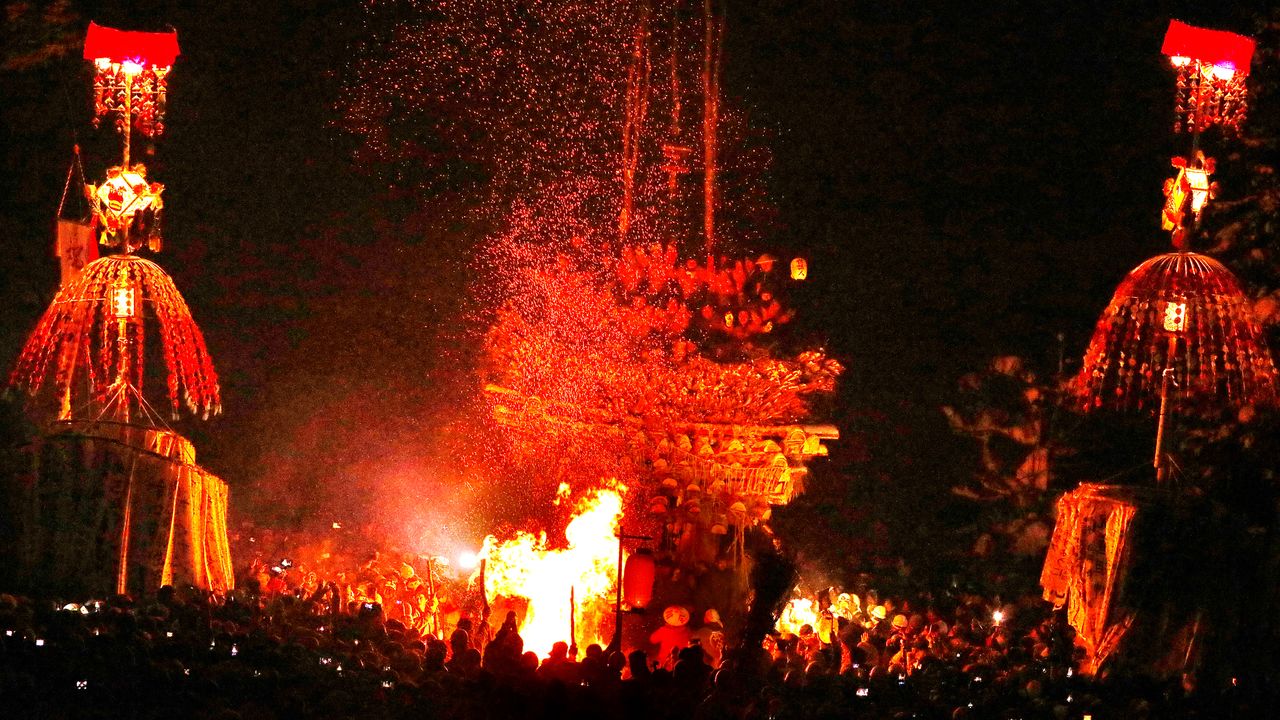
Clashes and Commotion: Battle-Themed Festivals in Japan
Guideto Japan
Culture- English
- 日本語
- 简体字
- 繁體字
- Français
- Español
- العربية
- Русский
Rites of Belligerency
Festival offerings to the divine often include food, entertainment, and prayer. But there are some rituals that are centered on combat and displays of raw energy. They can be so dangerous that they would surely be banned were they not time-honored rituals integral to a community’s identity.
There are several varieties of battle-themed festivals. One kind is a race with participants competing to capture a coveted prize. Another consists of matches between teams to forecast whether there will be a good harvest or catch. A third features brawls between floats or mikoshi (portable shrines), which are smashed into one another. The sight of gorgeous floats being destroyed—some being burned in the end—highlights the evanescent nature of these once-a-year events.
The winner is decided in advance in many of these festivals, and the battle scenes follow a script. This allows the crowd to cheer the participants on without worrying about their loved ones getting hurt. Below is an introduction to three of Japan’s best-known combat-style festivals.
Dōsojin Matsuri
(January 13–15, Nozawa Onsen, Nagano Prefecture)
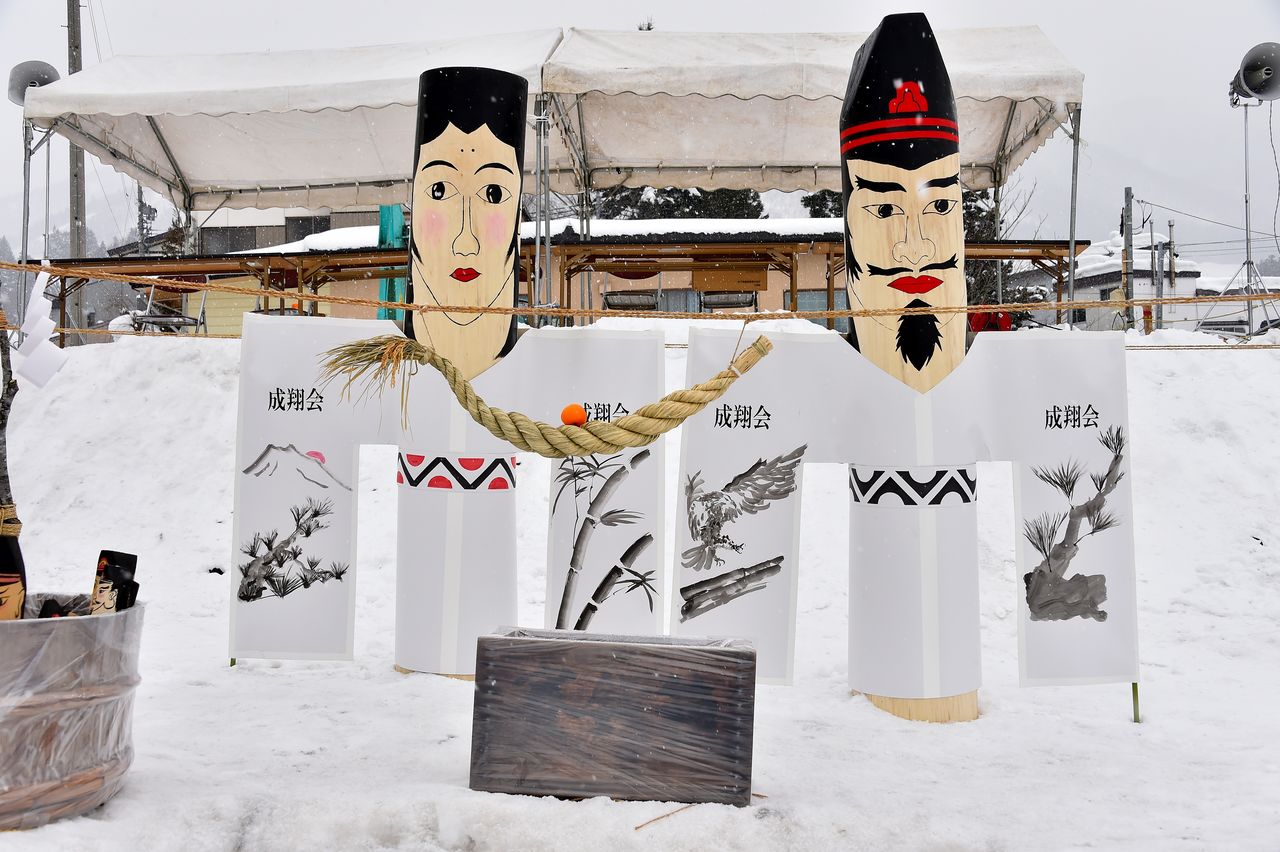
Male and female Dōsojin dolls are set up to pray for a good marriage and to be blessed with children. (© Haga Library)
The village of Nozawa Onsen is Japan’s only municipality with onsen (hot spring) in its name. As the appellation suggests, it is a historical resort town famed for its 13 public bathhouses. It is also noted for its high-quality powder snow, attracting nearly 140,000 skiers and snowboarders—many of them from abroad—to the village of less than 4,000 residents during the winter months. Perhaps unbecoming its image as a relaxing spa retreat, Nozawa Onsen also hosts the Dōsojin Matsuri around January 15 each year—often called the most dangerous festival in Japan.
Dōsojin are deities whose statues are commonly placed on the outskirts of hamlets, at major intersections, and along mountain passes to prevent malevolent spirits from harming residents. They are also thought to answer prayers for offspring, safe childbirth, and the healthy growth of youngsters. In Nozawa Onsen, they are usually depicted as a male-female pair, and statues can be seen not only along roads but also in shops, inns, and restaurants.
In many regions of eastern Japan, they are honored with a festival on koshōgatsu around January 15—when New Year’s decorations and calligraphy, along with talismans from the previous year, are burned in a ritual bonfire. The Dōsojin “fire festival” in Nozawa Onsen is known for being particularly fiery and brutal.
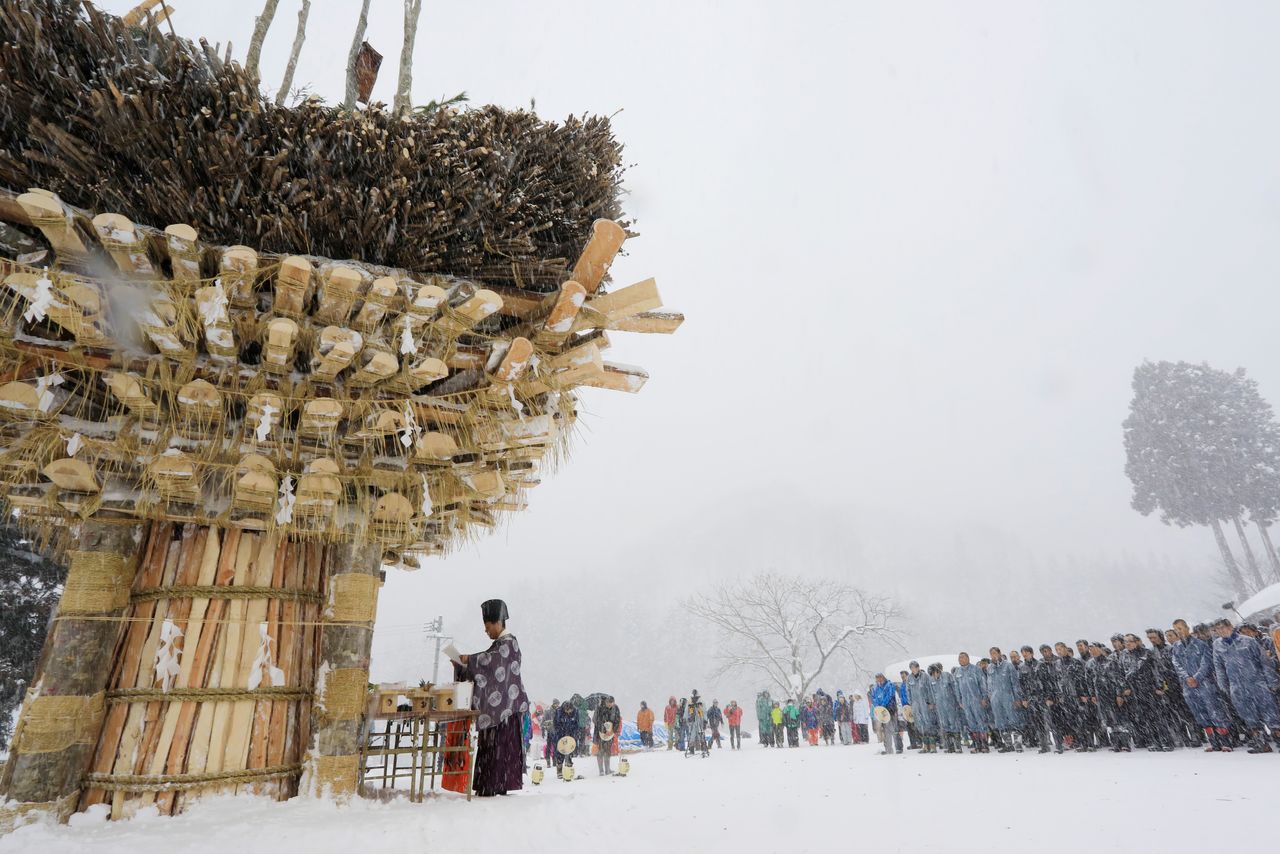
The newly completed shaden is blessed by a Shintō priest. (© Haga Library)
The festival begins on January 13, when sacred trees and other forest materials are brought to the village from nearby mountains. From early next morning to midday on January 15, the shaden—a tower rising over 10 meters high—is built using traditional construction methods, with no nails or wires. Construction of the festival’s main structure continues throughout the night.
Decorative, nine-meter-tall wooden lanterns are set up on either side of the tower. Offerings for these lanterns are made by families whose first son was born the previous year to pray for the child’s safe and healthy growth.
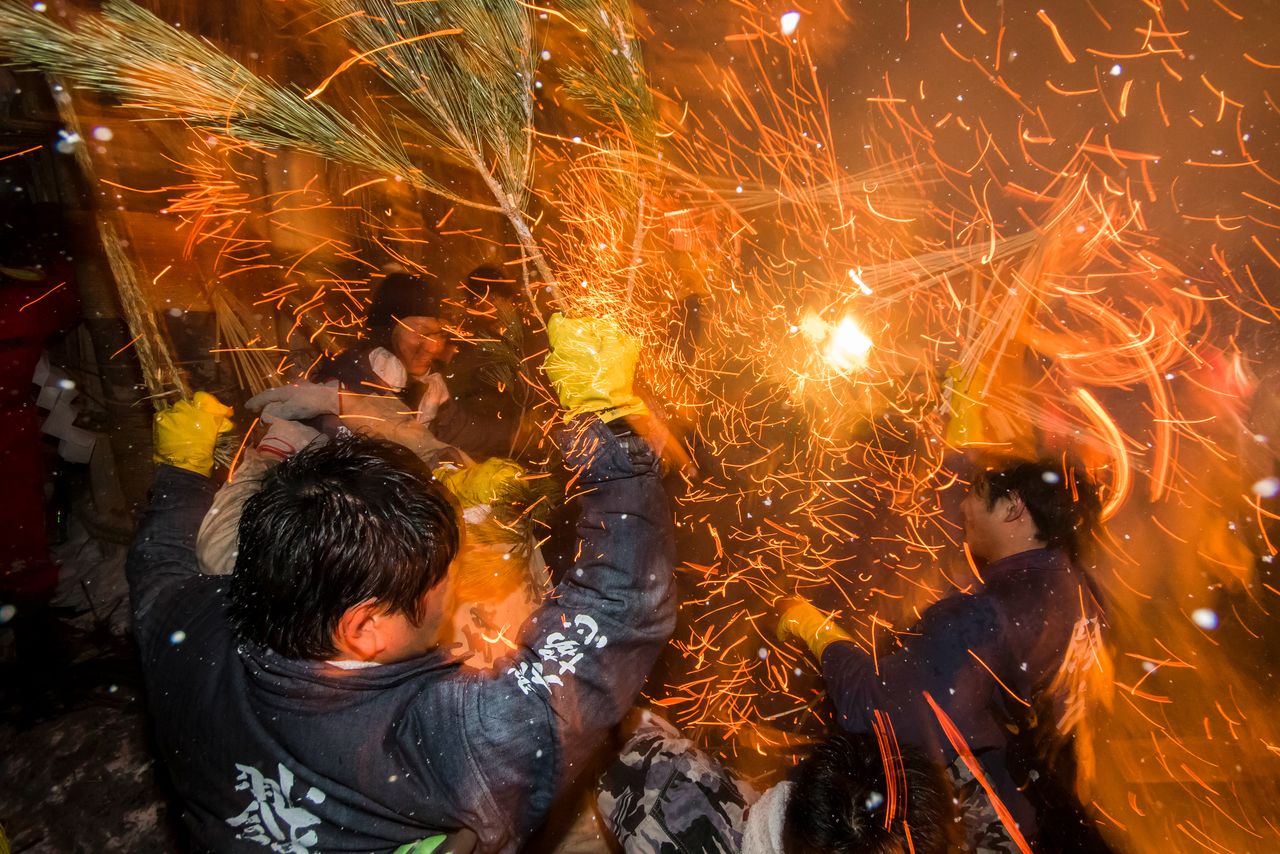
Sparks fly during the relentless assault on the shaden. (© Haga Library)
The climax of the festival is a battle staged on the night of January 15 between torch-bearing community representatives—local association officials, those who made offerings, other adults, and children—who storm the shaden in waves. Guarding the tower are male villagers in their “unlucky” years: 42-year-olds perched on the roof and 25-year-olds standing around the main entrance to bat down the torches of the attackers. The crowd roars, cheering the young men fending off the relentless assault.
Usually after about an hour and a half, the tower finally catches fire. The fighting is halted, allowing those on the roof to dismount, and the shaden, along with the wooden lanterns, bursts into flames and comes crashing to the ground. The flames are thought to exorcise evil spirits for the “unlucky” age cohorts, securing a successful year for all villagers. The ashes are taken home the next day as talismans to ward off fire.
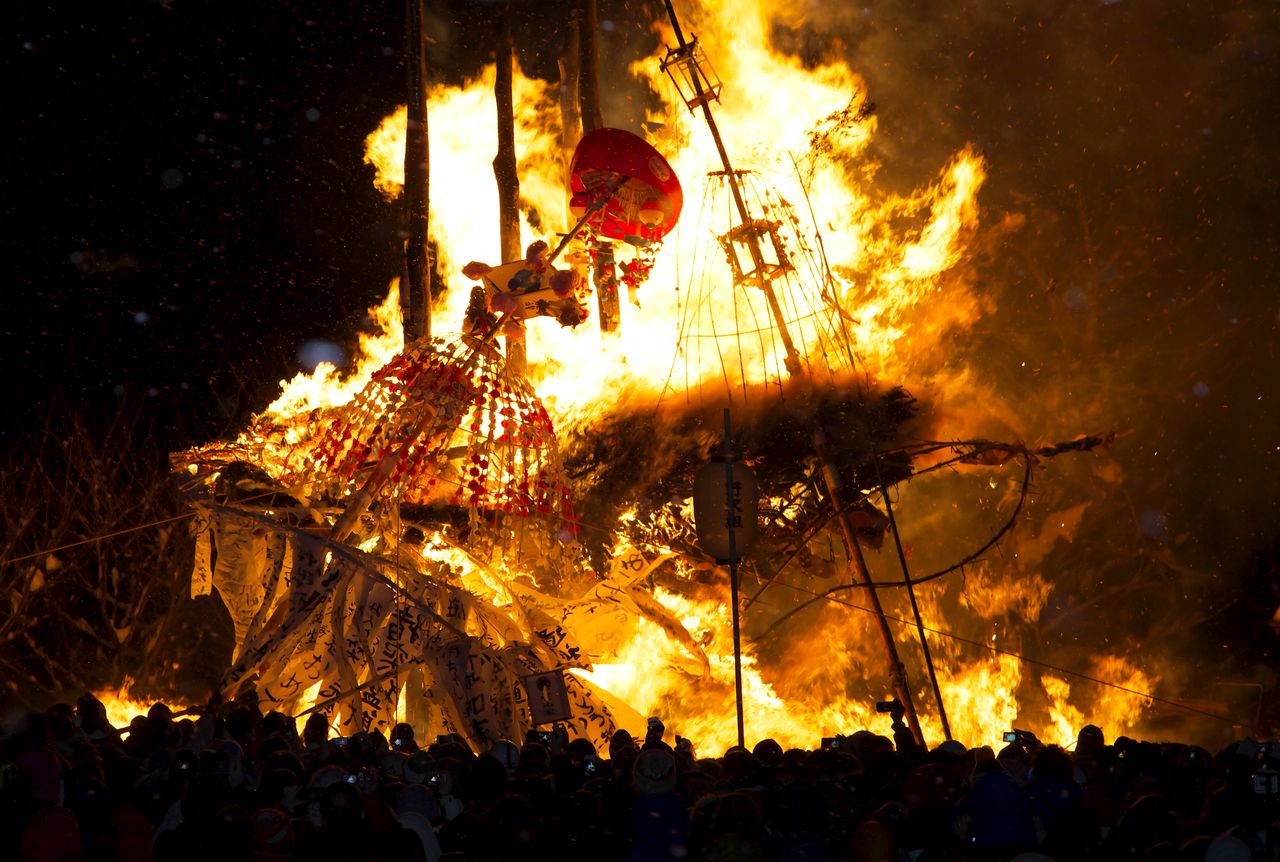
The shaden, along with the wooden lanterns, is engulfed in flames. (© Haga Library)
Toriou Matsuri
(The day before the first day of the rabbit in December, Imari, Saga Prefecture)
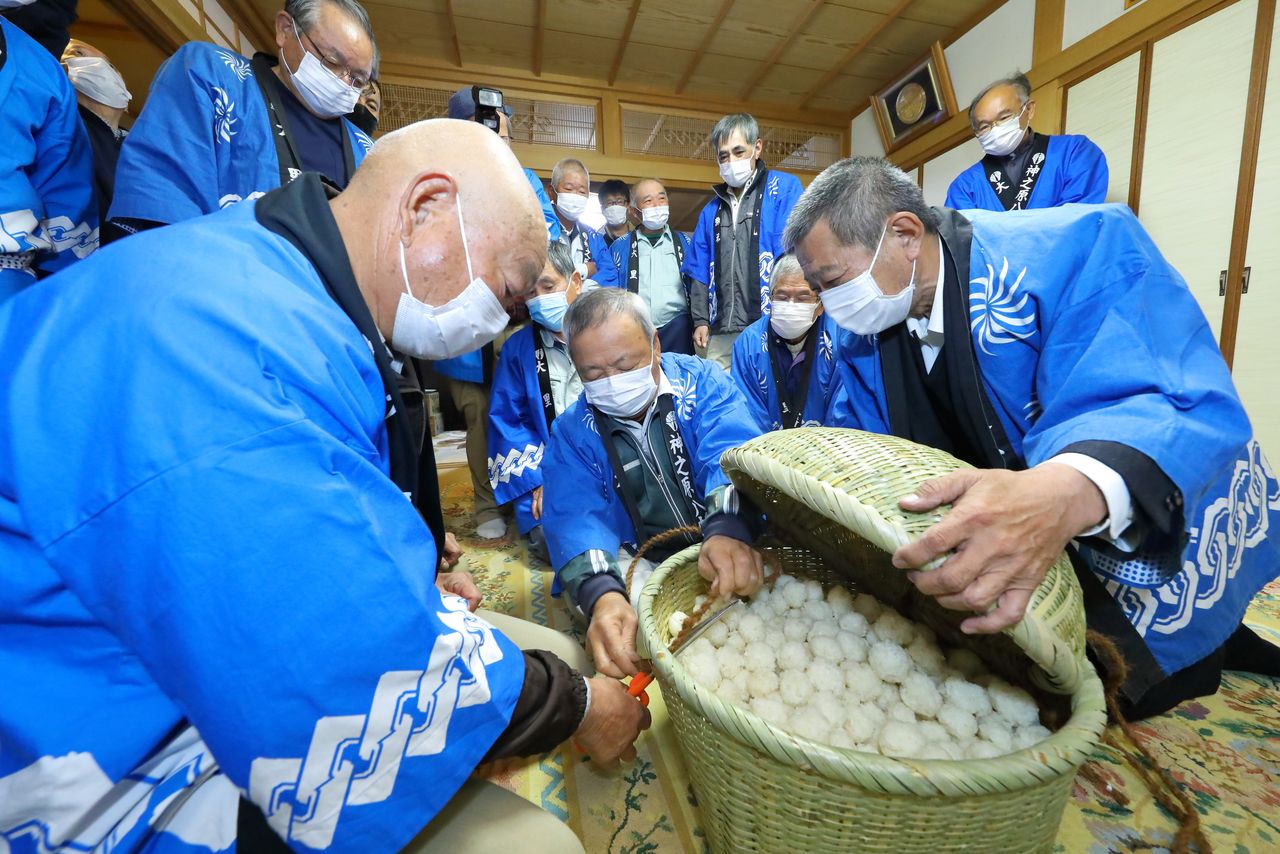
The 833 rice balls prepared for the festival are said to represent the number of warriors killed in a medieval battle. (© Haga Library)
The Toriou Matsuri is another festival featuring fiery encounters between combatants. Held at a shrine called Kaminohara Hachimangū in the city of Imari, western Saga Prefecture, it pits older parishioners seeking to protect gokū-san—a basket of rice balls—against younger assailants. Its origins are thought to go back some 700 years, when a warlord defeated in a battle between the Northern and Southern courts sought to regroup by training his men to withstand fire-filled onslaughts. It later evolved into a ritual to offer prayers for a bountiful harvest.
On the day of the festival, male residents press glutinous rice into 833 balls. At night, those charged with protecting gokū-san place the balls into a bamboo basket called tebo and carry it to the shrine. They use torches to fend off the attackers, who provoke them from behind.
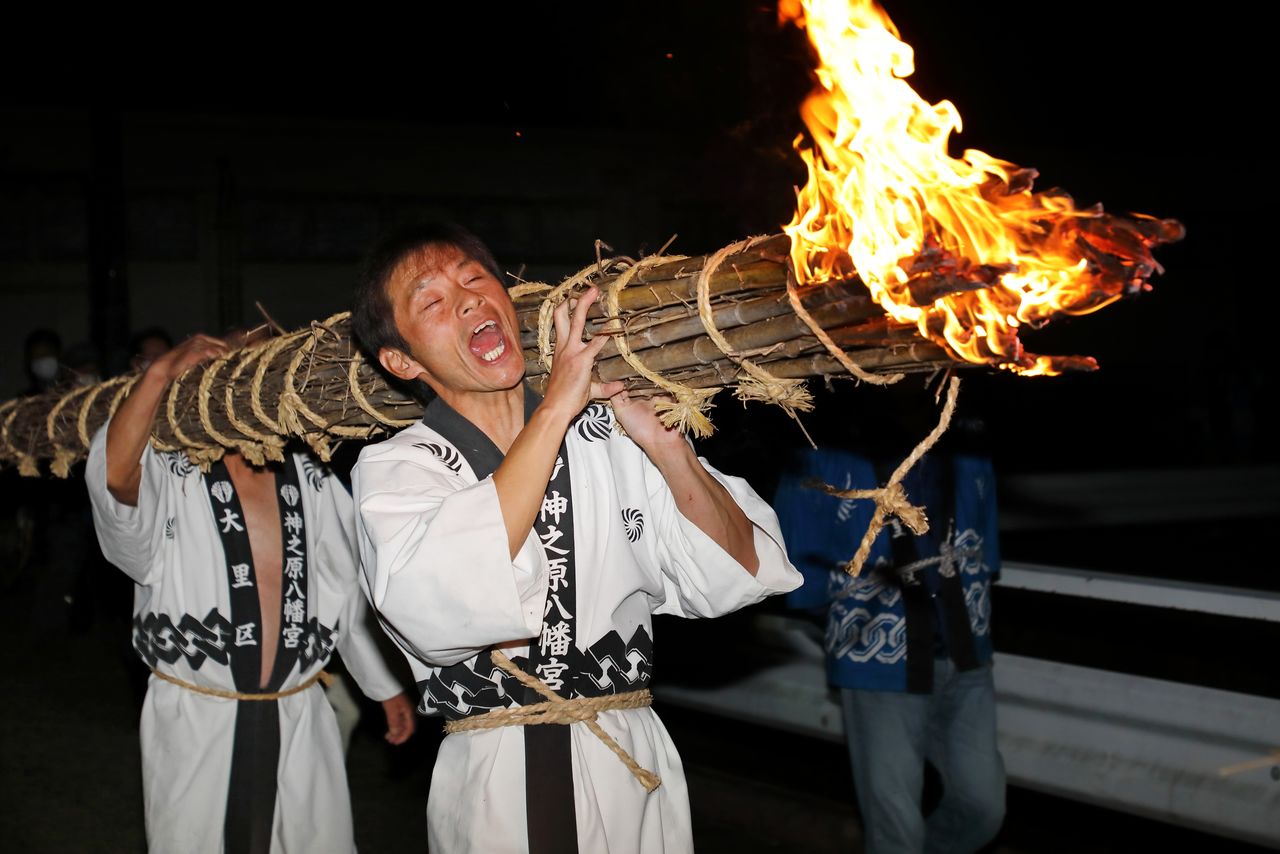
Entering the shrine carrying a large torch. (© Haga Library)
Once inside the shrine, the attackers are doused with a bucket of water as a purification rite, and the battle for the rice balls begins. The two sides duel verbally as sparks fly from torches that are batted against railings and on the ground. After about 15 minutes of intense fighting, the young assailants capture the basket, bringing the clash to a halt. The rice balls are taken from the basket and handed out to the assembled townspeople as offerings for their health and longevity.
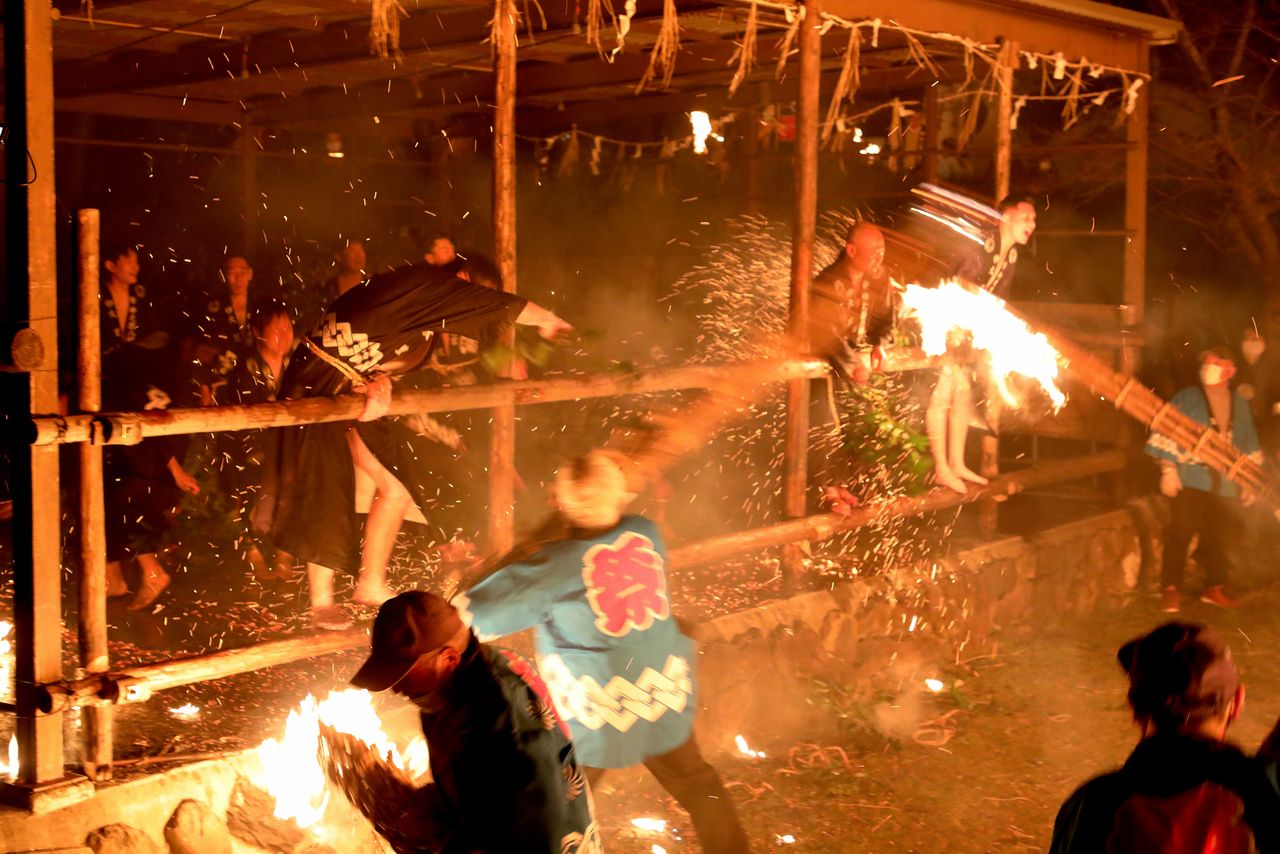
Younger participants use sakaki leaves to brush away the sparks from torches hurled against the railing by older residents. (© Haga Library)
Imazu Ōmikoshi
(October 7, Matsuyama, Ehime Prefecture)
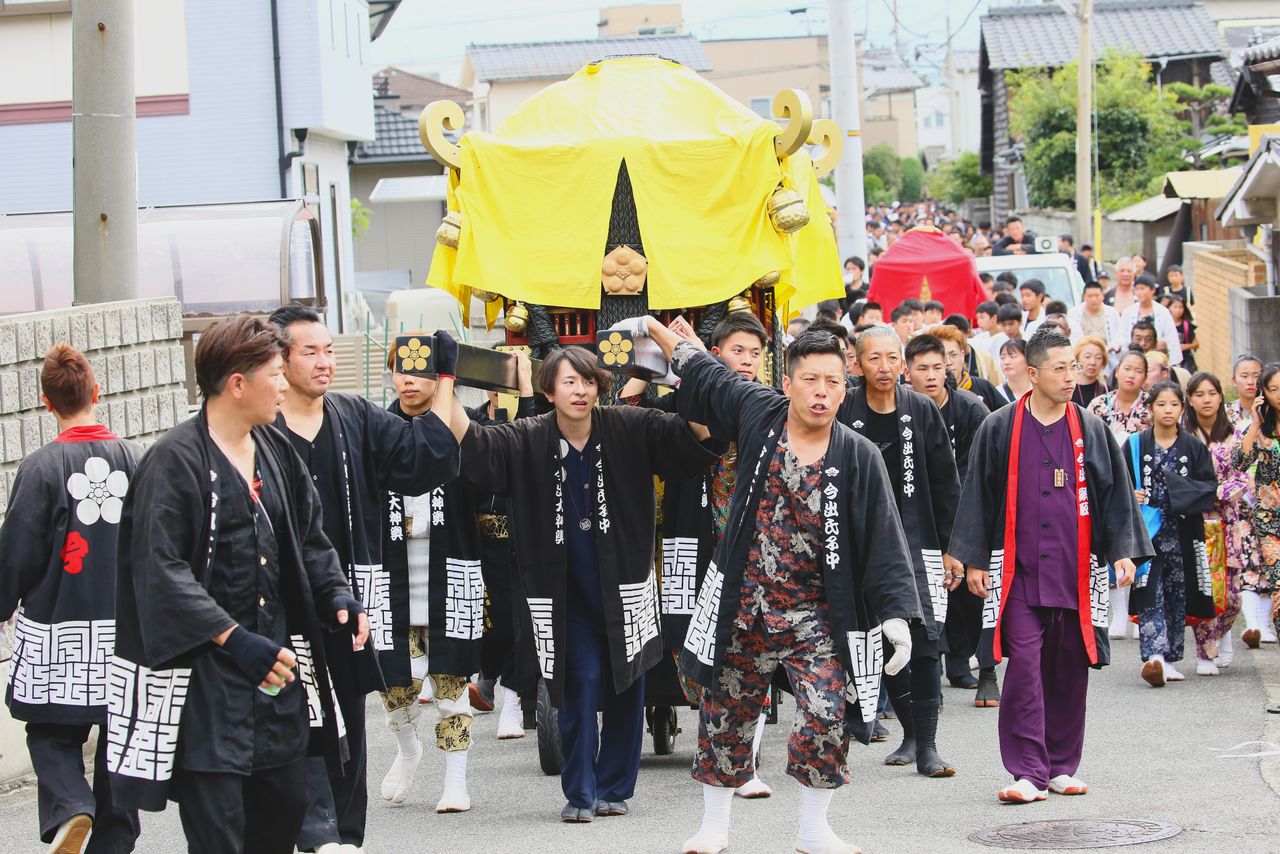
The festival mikoshi is paraded around the city throughout the day. (© Haga Library)
Matsuyama—the prefectural capital of Ehime on the island of Shikoku—is famous for its many high-spirited autumn festivals, with portable mikoshi shrines being hurled into rivers or smashed into one another to pray for good fish hauls and harvests. Among the most boisterous is the Imazu Ōmikoshi in Nishihabu, a fishing community in the southwestern corner of the city, where older iemochi residents battle younger ones over a mikoshi.
The festival is centered on the district’s Mishima Daimyōjin and Sumiyoshi Shrines. On the evening before the festival, two large mikoshi are showcased around the Mishima Daimyōjin grounds—the iemochi carrying an older mikoshi and the younger men hoisting the portable shrine from the previous year. A mikoshi damaged in an earlier matsuri must be repaired or newly built—a process that can take half a year.
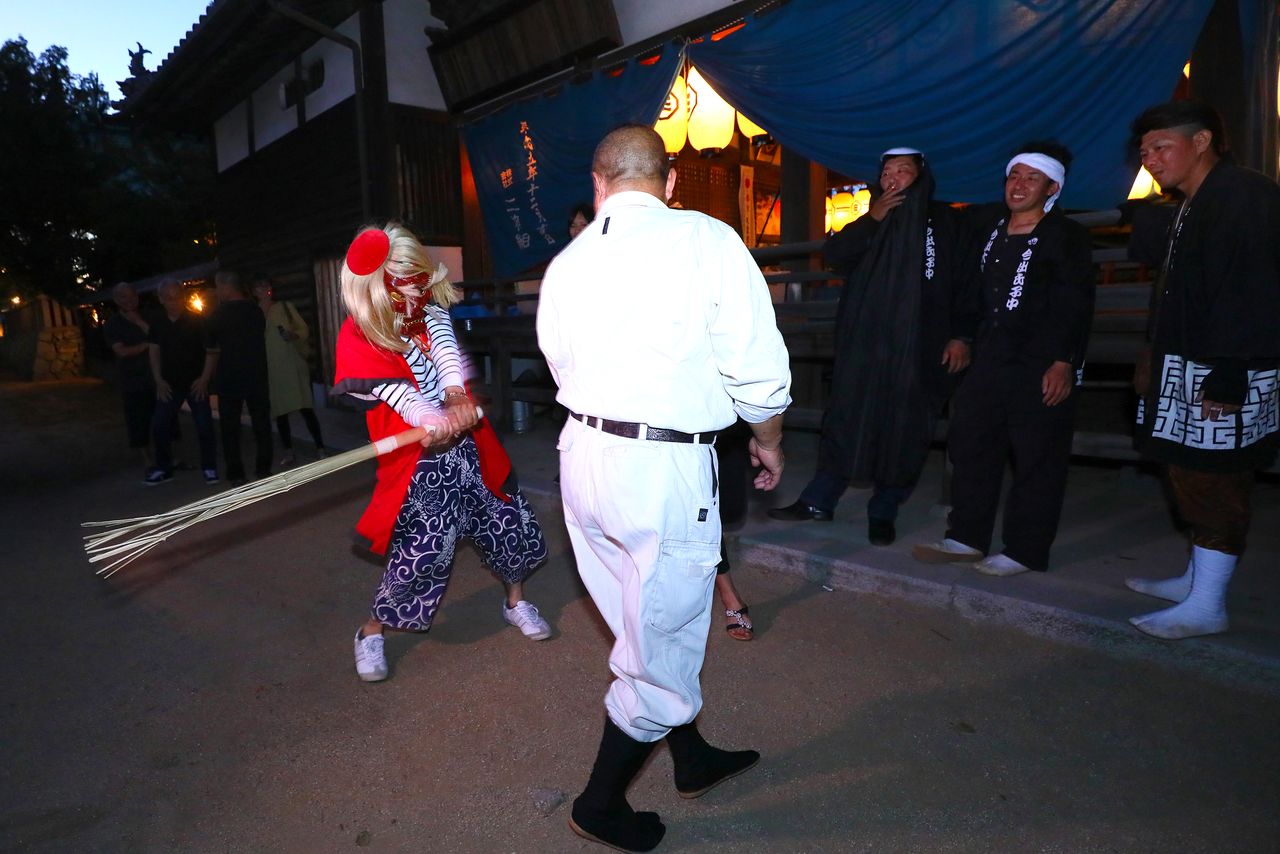
As the mikoshi are carried around the shrine grounds, a daiba wearing a demon’s mask swats people with a bamboo clatter stick to confer good health. (© Haga Library)
On the morning of the festival, the two mikoshi are taken to Sumiyoshi Shrine, where divine spirits are said to mount the palanquins, and from there are paraded over the next 10 hours through the streets of the city. They visit the homes of parishioners and cause great commotion, sometimes damaging the walls and ceilings of the entranceway. The residents usually make no effort to repair such scars, though, regarding them as propitious signs left behind by local deities.
At night, the mikoshi head back to Sumiyoshi Shrine, with lanterns lighting the way. The first to arrive are the iemochi, who await the arrival of the younger group at the shrine gate. This sets the stage for the clash between the two teams over three stages.
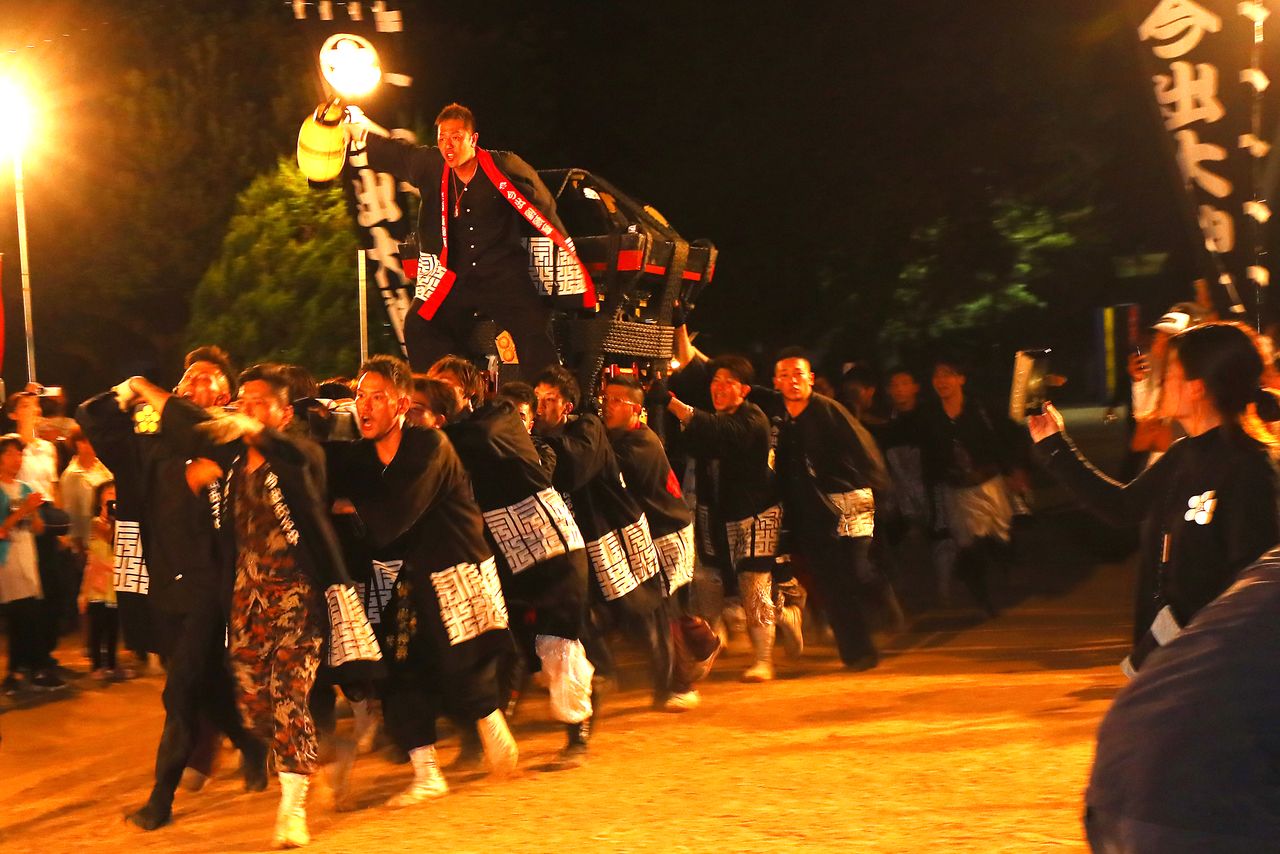
The group of younger men, cheered on by their children, charge the gate, seeking to enter the shrine grounds. (© Haga Library)
The younger group’s leader shouts to his fellow members, firing them up for the battle ahead. The mikoshi bearers charge the gate, seeking to break through the barricading elders, who are intent not to let the juniors enter the shrine without a fight. During the heated tussle, the mikoshi is forcibly knocked to the ground, along with those riding on it.
Once the mikoshi hits the ground, the two groups switch sides. This time, the iemochi zealously rush the gate as the young men seek to stop them in their tracks and knock the mikoshi down. The raids by both sides are then repeated, again with the mikoshi and its riders crashing to the ground.
On the third round, with voltage running high, the younger group finally succeeds in breaking through the blockade. The annual ordeal, while combative, is also a symbol of the older members’ desire to entrust the future to the younger generation—an opportunity for the community to physically come together as one.
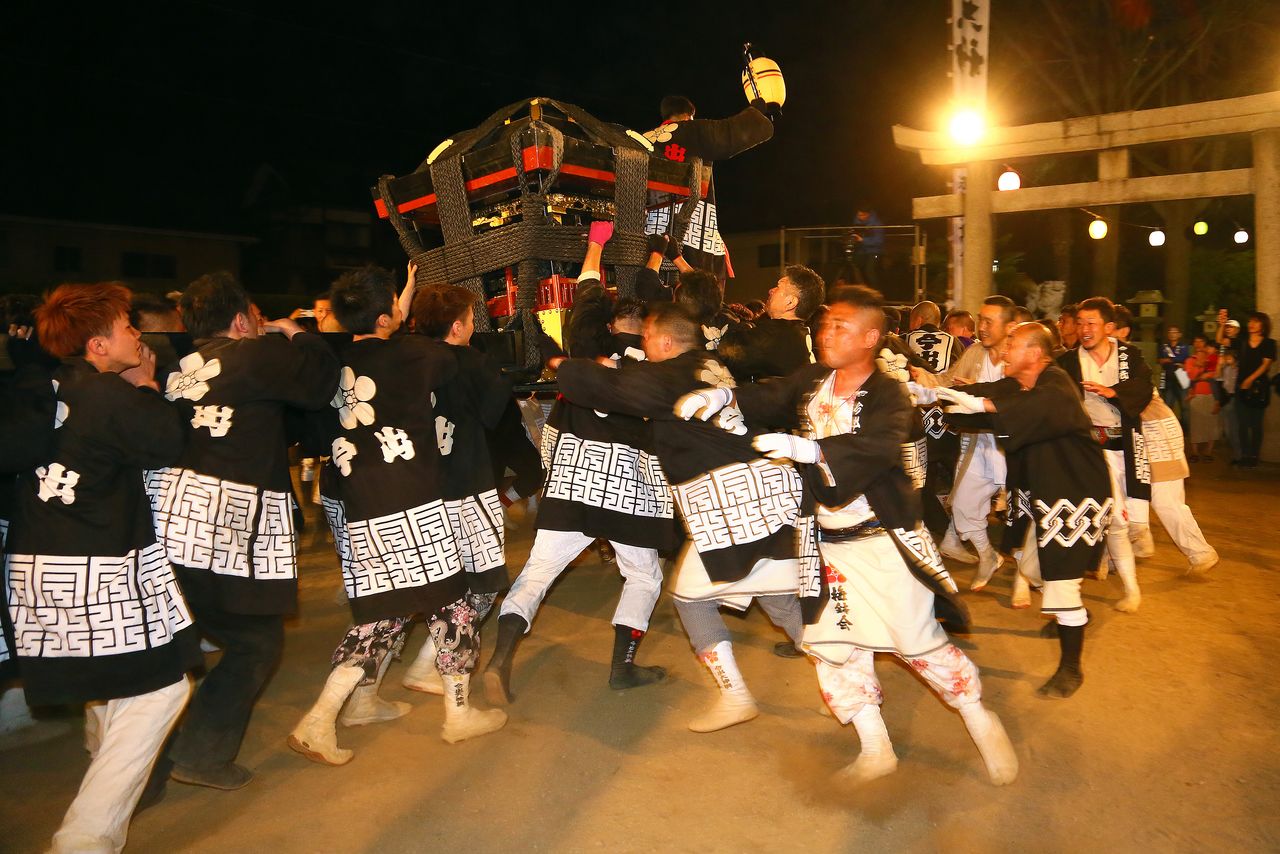
The mikoshi and those riding it come crashing to the ground during the tussle between teams of younger and older residents. (© Haga Library)
(Originally published in Japanese. Dates given are those on which the festivals are usually held. Banner photo: A scene from Dōsojin Matsuri. © Haga Library.)
